American Red Cross Advanced Life Support
Havard School
All 15 results
Sort by
AMERICAN RED CROSS ADVANCED LIFE SUPPORT COMPILED EXAMS 2023/24|ALL GRADED A+|DOWNLOAD TO PASS
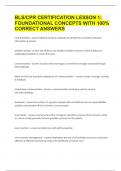
-
BLS CPR CERTIFICATION LESSON 1 FOUNDATIONAL CONCEPTS WITH 100% CORRECT ANSWERS
- Exam (elaborations) • 2 pages • 2023
- Available in package deal
-
- $12.99
- + learn more
critical thinking thinking clearly & rationally to identify the connection between information & actions problem solving the ability to use readily available resources to find solutions to challenging situations or issues that arise communication includes verbal messages & nonverbal messages conveyed through body language What are the four essential components of communication? sender, message, receiver, & feedback closed-loop communication a communication techni...

-
PEDIATRIC ADVANCED LIFE SUPPORT (PALS) |90 QUESTIONS AND ANSWERS.
- Exam (elaborations) • 21 pages • 2023
- Available in package deal
-
- $14.49
- + learn more
1 rescuer compression to breath ratio in pediatrics? 30:2 2 rescuer compression to breath ratio in pediatrics? 15:2 You need to provide rescue breaths to a child victim with a pulse. What is the appropriate rate for delivering breaths? A.) 1 breath every 3 to 5 seconds B.) 2 breaths every 6-8 secs C.) 1 breath every 6 secs D.) 1 breath every 10-12 secs A.) 1 breath every 3 to 5 seconds An infant's (birth-1 yr old) pulse is checked at the A.) Carotid artery B.) Femo...
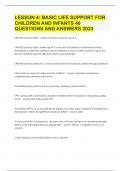
-
LESSON 4 BASIC LIFE SUPPORT FOR CHILDREN AND INFANTS 40 QUESTIONS AND ANSWERS
- Exam (elaborations) • 8 pages • 2023
- Available in package deal
-
- $14.49
- + learn more
CPR/AED protocol infant someone under the age of 1 CPR/AED protocol child age of 1 to the onset of puberty as evidenced by breast development in girls and underarm hair development in boys (usually around the age of 12). BUT be careful because the AED pad varies by age and weight. CPR/AED protocol adolescent someone from the onset of puberty through adulthood. Most common causes of cardiac arrest in pediatric? respiratory emergencies, congenital heart disorders and traum...
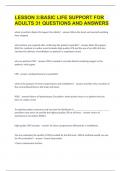
-
LESSON 3BASIC LIFE SUPPORT FOR ADULTS |31 QUESTIONS AND ANSWERS.
- Exam (elaborations) • 6 pages • 2023
- Available in package deal
-
- $12.99
- + learn more
when to perform Basic Life Support for Adults? When the heart and normal breathing have stopped what actions are required after confirming the patient needs BLS? Basic life support (BLS) for a patient in cardiac arrest includes high-quality CPR and the use of an AED. BLS also includes the delivery of ventilations to patients in respiratory arrest. why we perform CPR? CPR is needed to circulate blood containing oxygen to the patient's vital organs. CPR cardiopulmonary re...

-
PALS FINAL RED CROSS |50 QUESTIONS AND ANSWERS 2023.
- Exam (elaborations) • 7 pages • 2023
- Available in package deal
-
- $15.49
- + learn more
A 4-month old infant is brought to the emergency department in cardiac arrest. Which condition would the team identify as the most common cause of cardiac arrest in an infant of this age? sudden infant death syndrome is the most common cause in infants younger than 6 months of age. The PALS resuscitation team is providing care to an intubated child in cardiac arrest. Which result best determines the adequacy of the team's chest compressions? End-tidal carbon dioxide level between 15 an...
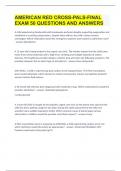
-
AMERICAN RED CROSS-PALS-FINAL EXAM |50 QUESTIONS AND ANSWERS
- Exam (elaborations) • 0 pages • 2023
- Available in package deal
-
- $13.99
- + learn more
A 12-year-old is being treated in the urgent care clinic. The mother reports that the child came home from school yesterday with a high fever, vomiting and multiple episodes of watery diarrhea. The healthcare provider obtains a rhythm strip and notes the following waveform. The provider interprets this as which type of arrhythmia? Sinus tachycardia After ROSC, a child is experiencing post-cardiac arrest hypoperfusion. The PALS resuscitation team would administer which element to restore ...

-
AMERICAN RED CROSS BASIC LIFE SUPPORT |100 QUESTIONS AND ANSWERS.
- Exam (elaborations) • 19 pages • 2023
- Available in package deal
-
- $13.99
- + learn more
You use critical thinking when you: Perform a rapid assessment and determine a course of action. Anticipate roles and functions as part of a team based on the patient's presentation and condition. Re-evaluate the situation for changes, interpret these changes and modify care accordingly. Closed-loop communication A communication technique used to prevent misunderstandings; the receiver confirms that the message has been received and understood. Team Leader Responsibilities...
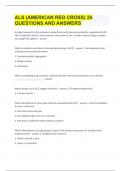
-
ALS (AMERICAN RED CROSS)| 25 QUESTIONS AND ANSWERS.
- Exam (elaborations) • 4 pages • 2023
- Available in package deal
-
- $13.99
- + learn more
A patient presents to the emergency department with signs and symptoms suggestive of ACS. The 12-lead ECG shows T-wave inversion of less than 2 mm. To which clinical category would you assign this patient? Which conditions contribute to the pathophysiology of ACS? 1. Development of an occlusive intracoronary thrombus 2. Transient platelet aggregation 3. Plaque erosion 4. Vasospasm When auscultating lung sounds in a patient with left ventricular dysfunction, you will hear ______...
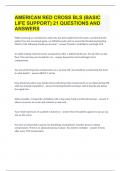
-
AMERICAN RED CROSS BLS (BASIC LIFE SUPPORT) |21 QUESTIONS AND ANSWERS
- Exam (elaborations) • 3 pages • 2023
- Available in package deal
-
- $14.99
- + learn more
While assessing an unresponsive adult who has been pulled from the water, you find that the patient has only occasional gasps, no definitive pulse and no severe life-threatening bleeding. Which of the following should you do next? Provide 2 ventilations and begin CPR An adult choking victim becomes unresponsive after 7 abdominal thrusts. You lay them on the floor. The next step you should do is to: Expose the chest and begin chest compressions. You are performing chest compressio...

Did you know that on average a seller on Stuvia earns $82 per month selling study resources? Hmm, hint, hint. Discover all about earning on Stuvia


